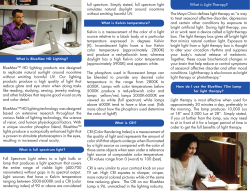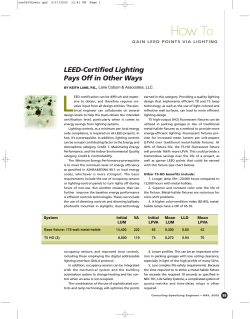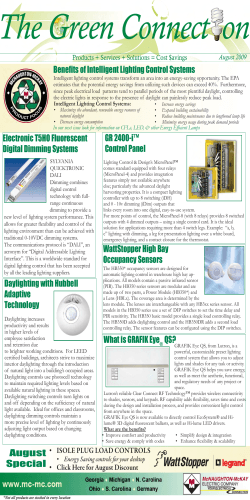
H Why Use Supplemental Lighting for Indoor or Greenhouse Gardening?
Why Use Supplemental Lighting for Indoor or Greenhouse Gardening? H igh intensity discharge (H.I.D.) lighting has traditionally been used only by commercial growers in large scale greenhouses. These business savvy professionals have long understood the exceptional benefits of supplemental, artificial lighting for plant growth. From stronger, healthier seed starts, into faster maturing, vigorous plants that offer much higher yields and more spectacular flowering than can be achieved without supplemental lighting. H.I.D. lighting not only supplements sunlight, but can actually replace it during long winters where sunlight is in short supply. It is very energy efficient and the cost of operating one of our light systems is comparable to using one of your kitchen appliances. Plants need light for proper growth. The light spectrum range produced by artificial light (particularly H.I.D. light) enhances the natural light derived from the sun by many times over. The result… when combined with proper nutrients… is nothing short of AMAZING! And the best news is… this technology once LINEAR FLUORESCENTS raditional T12 and T8 fluorescent lighting is simply not powerful enough to light an area more than 8-10 inches below the bulb. With the recent introduction of the highly efficient T5 technology, T5 linear fluorescent fixtures can now put out a respectable 92.6 lumens per watt. T12 lamps typically put out about 30 lumens per watt. T5 fixtures are excellent for starting seeds and cuttings, but are also able to produce enough light for full T available only to the commercial market is now available to you. All this being said, what can supplemental lighting do for a home, hobby grower? • S ignificantly increase the health, strength, growth rate & yield of your plants. • Supplement natural sunlight in your backyard greenhouse virtually eliminates seasonal & geographical restraints. In addition, by extending the “day length” with supplemental lighting, you will greatly enhance your growing success. • Indoor gardening – Why settle for gardening just a few months of the year? By using one of our light fixtures as a primary light source indoors, you can enjoy the hobby of gardening all year long! High Intensity Discharge lighting systems have revolutionized indoor gardening in the last two decades. They are the most energy efficient grow lights available, so they produce much more light for the amount of power consumed. • c ontainer plants that are outdoors on decks & patios during the summer can be moved indoors during the winter under H.I.D. or high output fluorescent light allowing them to thrive year round. term growth. Because of their minimal heat output, they can be placed very close to the plant canopy to maximize the light output. HIGH WATTAGE SELF BALLASTED GROW LAMPS These lamps have become quite popular in the recent past. We offer EcoPlus® brand 105 & 150 watt mogul base fluorescent lamps that put out about 70 lumens per watt. They are excellent for starting seeds or to use over a LIGHT OUTPUT COMPARISON CHART The lumen output is the same for each of these five scenarios shown below. Each represents a total lumen output of approximately 50,000. National Garden Wholesale® • Web www.nationalgardenwholesale.com West 888.478.6544 • SW 888.888.3319 • East 888.265.9005 • SE 877.649.3567 small garden area. INCANDESCENT LAMPS These standard household bulbs do not emit enough light, or the proper spectrum to be used by serious gardening enthusiasts. They are not very efficient, using a considerable amount of power for the light they emit. They are typically only about 15 lumens per watt. Which Light is Right for You? Most gardeners use at least 25 watts per square foot of garden space. You may need less if your light is used to supplement natural sunlight, or if you are growing a plant that does not require as much light (ie: lettuce). However, many gardeners prefer to double or even triple the recommended wattage to achieve faster growth rates. There is really no such thing as too much light, but using a big light in a small space will sometimes result in high temperatures that are difficult to control. Keep in mind that plants need periods of darkness too. Most indoor gardeners use lighting from 12 - 18 hours per day. QUICK REFERENCE/CONVERSIONS Hanging height general guideline for the proper hanging height of an H.I.D. lamp would be 12”-48” depending on wattage (see below). Make sure to check for excessive heat at the top of your plants by placing your hand (palm down) over your plants. If the top of your hand is hot, you need to move your lamp up higher. If the light source is too close to your plants, you can burn them. Remember that as your plants grow you will need to adjust the height of your lamp. A Please keep in mind that the latest aircooled reflectors, like the Super Sun® 2 allow you to place higher wattage bulbs closer to plants than was possible in the past. When you raise the light up & away from your plants, you need to be aware of the light levels at your plants will be significantly reduced. As light moves away from its source (the lamp) it diminishes as follows: 1/Distance2. For example: 1ft. = 1000 FC, 2ft. = 250 FC, 3ft. TYPICAL MOUNTING HEIGHTS HIGH WATT SYSTEM MEDIUM WATT SYSTEM LOW WATT SYSTEM 18” − 48” 12” − 36” I Your style of gardening will determine which type of light is best for you. But whichever model you choose, you can be assured that your investment QUICK REFERENCE/CONVERSIONS Coverage area fluorescent fixture can be placed much closer to plants than an H.I.D. fixture because it produces very little heat. You should place your fluorescent lights as close to the tops of your plants as you can without excluding the outside perimeter of your garden. A H.I.D. Average Coverage Area by Wattage 150/175 watts covers approx 2’ x 2’ area 250 watts cover approx. 3’ x 3’ area 400 watts covers approx. 4’ x 4’ area 600 watts covers approx. 6.5’ x 6.5’ area 1000 watts covers approx. 8’ x 8’ area NOTE: Coverage area may be reduced if this is your primary light source. 12” − 24” HIGH PRESSURE SODIUM (hps) OR METAL HALIDE (MH) f you choose H.I.D. as your source of lighting, you have another choice...HPS or MH. Sunlight Supply®, Inc. offers lights in MH and HPS. Metal Halide (MH) bulbs emit a light spectrum which appears blue-white to the human eye. This color spectrum is more conducive for vegetative growth, or starting seeds and cuttings. High Pressure Sodium (HPS) bulbs emit a spectrum which is more concentrated in red/orange light. This color is ideal for the fruiting and flowering stage of a plant’s development. It is a good multi-purpose light as well. = 111 FC, 4ft. = 63 FC, 5ft. = 40 FC, & 6ft. = 28 FC. into the lighting technology used by the professional will be rewarded by increased, nutrition packed yields, lovelier flowers and healthier plants! LIGHT REQUIRED FOR PHOTOSYNTHESIS nly part of solar radiation is used by plants for photosynthesis. The photosynthetically active radiation (PAR) contains the wavelengths between 400 and 700 nanometers, and falls just within the so-called visible spectrum (380-770nm). The total visible spectrum is perceived by us humans as white light, but with the aid of a prism, we see that the “white” light is actually separated into a spectrum of colors from violet to blue, to green, yellow, orange and red. Plants use the blue to red light as their energy source for photosynthesis. O National Garden Wholesale® • Web www.nationalgardenwholesale.com West 888.478.6544 • SW 888.888.3319 • East 888.265.9005 • SE 877.649.3567
© Copyright 2026





















